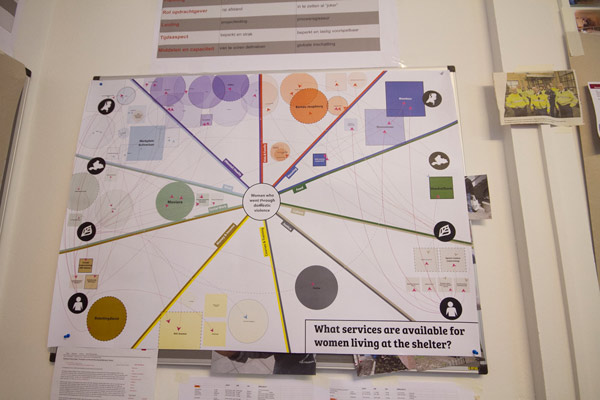Categories
“Here, I’m just a person that needs to be changed.”
Stefanie is 19 years old. Two months ago, she left her life. For the shelter. She exchanged playing soccer, hanging out with friends, holding 2 jobs, and shopping with 4 hours of therapy and a whole lot of crying. “It’s so irritating always talking about my past. I feel like crap when I talk about it all. And then I come home to cry and feel bad the rest of the day. I just want to talk about my future.”
Stefanie is one of 19 women we’ve had the privilege of getting to know. As part of our Apeldoorn Starter Project. With Kennisland.
Monday, our project team came together. (With special guest Joanne Cave). To look across the 19 stories of women and the 9 stories of professional service providers. We wanted to make sense of what we were hearing, seeing, and feeling. But we didn’t just want to analyze what was happening. We wanted to generate concrete scenarios for what could be different.

We started with comparing and contrasting women of:
- different ages
- cultural reference points
- value sets
- education levels
- work experience
- communication styles
- size of social networks
- density of social networks
- diversity of social networks
- function of social networks
- perceived support
- perceived loneliness
- coping methods
- recovery phase
- preferred outcomes
- distance from outcomes
- real & perceived control

From all the categorizing, regrouping, and debating, a few key tensions rose to the surface:
What (many) women see as a good outcome is perceived as beyond the scope of every service we’ve shadowed. Professional services are tightly bounded. There’s a heck of a lot of redundancy. But very little variation in practice.

Most services define a good outcome in terms of the receipt of help, harm minimization, or getting by in the ‘real world.’ In other words: it’s good when women get the services they need; it’s good when women are safe; it’s good when women have a home, a job, an income. And yet going after these outcomes is actively dis-enabling many women from moving forwards. From stepping away from the drama. From being & belonging. From using & enjoying their capabilities. Women are placed in a home far away from the little social network they have left. Women have 4 social workers added to their life, and no friends. Women are kept physically safe, but isolated from all of the activities that give their life some sort of color and verve.
Isolation and loneliness appear as main characters in every story. Because when you leave a domestic violence situation, your natural network shrinks. In addition to the relationship with the abuser, 80% of the women we’ve met are also estranged from a parent or sibling. They come to a shelter. And forge fast, volatile friendships with other women in the exact same situations as them. Most of these friendships do not last. Nor do their relationships with professionals. Who come & go as soon as they move to a new community. And whose narrowly prescribed role means most of what they do is broker to other professionals who might be able to help. For over half of the women we’ve met, professionals of this sort make up more of their network than friends or family members.
The big question, then, is: what could we add to women’s contexts, take away, or tweak to enable being & belonging, using & enjoying capacities, and less drama?

Over the next two weeks, we’ll be writing & visualizing 10+ scenarios. For everything from neighborhood home stays & revised housing allocation policies; to new hiring & contracting processes for social workers; to different interactions at the Benefits Office and Immigration. It’s clear no one solution will be enough. We need to prototype a range of new roles, networks, services, and policies.
Behind each of our 10+ scenarios lies a belief in maximalist not minimalist outcomes. That when services & policies set the bar to the basics – shelter, housing, food – they inadvertently get in the way of all the stuff that makes a life more than a set of transactions and tasks. It’s here we’re encountering strongly held cultural and historical paradigms. About the role of professionals & the public service in Dutch life.
We’ve never shied away from a good challenge.